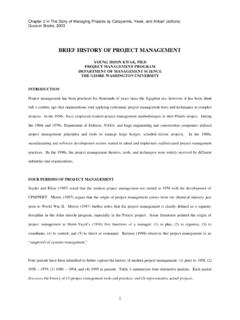Transcription of BRIEF HISTORY OF PROJECT MANAGEMENT
1 Chapter 2 in The Story of Managing Projects by Carayannis, Kwak, and Anbari (editors) Quorum Books, 2003 1 BRIEF HISTORY OF PROJECT MANAGEMENT YOUNG HOON KWAK, PROJECT MANAGEMENT PROGRAM DEPARTMENT OF MANAGEMENT SCIENCE THE GEORE WASHINGTON UNIVERSITY INTRODUCTION PROJECT MANAGEMENT has been practiced for thousands of years since the Egyptian era, however, it has been about half a century ago that organizations start applying systematic PROJECT MANAGEMENT tools and techniques to complex projects. In the 1950s, Navy employed modern PROJECT MANAGEMENT methodologies in their Polaris PROJECT . During the 1960s and 1970s, Department of Defense, NASA, and large engineering and construction companies utilized PROJECT MANAGEMENT principles and tools to manage large budget, schedule-driven projects. In the 1980s, manufacturing and software development sectors started to adopt and implement sophisticated PROJECT MANAGEMENT practices.
2 By the 1990s, the PROJECT MANAGEMENT theories, tools, and techniques were widely received by different industries and organizations. FOUR PERIODS OF PROJECT MANAGEMENT Snyder and Kline (1987) noted that the modern PROJECT MANAGEMENT era started in 1958 with the development of CPM/PERT. Morris (1987) argues that the origin of PROJECT MANAGEMENT comes from the chemical industry just prior to World War II. Morris (1987) further notes that the PROJECT MANAGEMENT is clearly defined as a separate discipline in the Atlas missile program, especially in the Polaris PROJECT . Some literatures pointed the origin of PROJECT MANAGEMENT to Henri Fayol s (1916) five functions of a manager: (1) to plan, (2) to organize, (3) to coordinate, (4) to control, and (5) to direct or command. Kerzner (1998) observes that PROJECT MANAGEMENT is an outgrowth of systems MANAGEMENT .
3 Four periods have been identified to better capture the HISTORY of modern PROJECT MANAGEMENT : (1) prior to 1958, (2) 1958 1979, (3) 1980 1994, and (4) 1995 to present. Table 1 summarizes four distinctive periods. Each period discusses the HISTORY of (1) PROJECT MANAGEMENT tools and practices and (2) representative actual projects. Chapter 2 in The Story of Managing Projects by Carayannis, Kwak, and Anbari (editors) Quorum Books, 2003 2 Periods Theme Sub context Prior to 1958 Craft system to Human Relations Administration 1958 1979 Application of MANAGEMENT Science 1980 1994 Production Center: Human Resources 1995 to present Creating a new environment PROJECT MANAGEMENT Actual Projects Table 1. Four periods of PROJECT MANAGEMENT PRIOR TO 1958: CRAFT SYSTEM TO HUMAN RELATIONS ADMINISTRATION PROJECT MANAGEMENT The origin of the modern PROJECT MANAGEMENT concept started between 1900s and 1950s.
4 During this time, technology advancement shortened the PROJECT schedule. Automobiles allowed effective resource allocation and mobility. Telecommunication system increased the speed of communication. The job specification was widely used and Henry Gantt invented Gantt chart. The job specification later became the basis of developing the Work Breakdown Structure (WBS). Actual Representative Projects Juhah s PROJECT Plan for Building Pacific Railroad In Judah s (1857) "A Practical Plan for Building the Pacific Railroad," engineers and clerks at the PROJECT office prepared a formal report upon arrivals of survey information from the field managers. Once the data has been updated and analyzed, the PROJECT office forwarded orders to resident engineers, and field managers initiated the PROJECT . The PROJECT office also dealt with relationship with investors, field survey, cost estimation, feasibility study, and others.
5 PROJECT office simply functioned as an administrative office. Hoover Dam (1931 1936) In 1928, the congress passed the Boulder Canyon Act assigning $175 million to the Hoover Dam. The Big Six that consists of Utah Construction, Pacific Bridge, Kaiser, MacDonald and Kahn, Morrison-Knudsen, and Shea formed a consortium to work as a general contractor. It was crucial for the companies to have a detail PROJECT planning, controlling, and coordinating plan because the PROJECT involved six independent companies. The Chapter 2 in The Story of Managing Projects by Carayannis, Kwak, and Anbari (editors) Quorum Books, 2003 3 construction site was located in the middle of the desert with no infrastructures. Boulder City was created to accommodate their workers to stay near the construction site. The PROJECT required both physical and human resources.
6 The PROJECT employed approximately 5,200 workers, and large amount of construction resources including concrete, structural steel components, steel pipe, and so on were required (Bureau of Reclamation 1985). The PROJECT was successfully completed under budget and ahead of schedule (Moore 1999). The Hoover dam PROJECT is still one of the highest gravity dams in the , which generates more than four billion kilowatt-hours a year. Manhattan PROJECT (1942 1945) The Manhattan PROJECT was the pioneer research and development (R&D) PROJECT that designed and built the atomic bomb. The initial PROJECT was proposed in 1939 to defend possible threats from Germany. In 1941, the Office of Scientific Research and Development (ORSD) were established to coordinate government-sponsored projects, and the Manhattan PROJECT initiated in 1942.
7 The OSRD coordinated universities and resources for the research and development of the atomic bomb. The PROJECT was successfully tested in July of 1945, a month before the bomb was dropped on Hiroshima, Japan. The PROJECT involved 125,000 labors, and cost nearly $2 billion. 1958-1979: APPLICATION OF MANAGEMENT SCIENCE PROJECT MANAGEMENT There were significant technology advancement between 1958 and 1979. In 1959, Xerox introduced the first automatic plain-paper copier. In the 1960s, many industries were influenced by the development of silicon chips and minicomputers. In 1969, Bell Laboratories developed programming language UNIX and computer industry started to develop rapidly. NASA s successful Apollo PROJECT earmarked a historic event of the mankind. In 1971, Intel introduced 4004, a 4-bit microprocessor, which is a foundation of the evolution of Intel s 80386, 80486, and Pentium processors in the 1990s.
8 While many dedicated scientists developed ARPANET, Ray Tomlinson in 1972 introduced the first e-mail software. In 1975, Bill Gates and Paul Allen founded Microsoft. Several PROJECT Chapter 2 in The Story of Managing Projects by Carayannis, Kwak, and Anbari (editors) Quorum Books, 2003 4 MANAGEMENT software companies were founded during the 1970s including Artemis (1977), Scitor Corporation (1979), and Oracle (1977). Between 1950 and 1979, several core PROJECT MANAGEMENT tools including CPM/PERT, Material Requirement Planning (MRP) and others were introduced. CPM/PERT was calculated in large computer systems, and specialized programmers operated the CPM/PERT mainly for the government sector projects. The common organizations used the PROJECT office as brokers of information having small number of skilled schedulers and estimators (Vandersluis 1998).
9 Actual Representative Projects Polaris PROJECT (1956 1961) The Polaris PROJECT refined the PROJECT MANAGEMENT concepts as known today (Sapolsky 1972). The $11 billion Polaris PROJECT was undertaken by the government to deliver nuclear missiles carried by submarines, known as Fleet Ballistic Missile. The PROJECT was initiated by Navy in late 1956, and successfully launched its first Polaris missile in 1961. The Navy created a new unit called Special PROJECT Office (SPO) to avoid giving the Polaris PROJECT to Bureau of Ordinance and Bureau of Aeronautics (Sapolsky 1972). Apollo PROJECT In 1958, National Aeronautics and Space Administration (NASA) was created. Between 1969 and 1972, NASA successfully led six missions to explore the moon. In 1960, NASA set up the Apollo program office to provide following functions: Maintain and schedule Apollo missions using PERT.
10 Procurement and contracting with suppliers such as GE. Develop MANAGEMENT system to measure the performance. Set up a focal point of the Apollo program. Chapter 2 in The Story of Managing Projects by Carayannis, Kwak, and Anbari (editors) Quorum Books, 2003 5 ARPANET The Internet is as much a collection of communities as a collection of technologies, and its success is largely attributable to both satisfying basic community needs as well as utilizing the community in an effective way to push the infrastructure forward. This community spirit has a long HISTORY beginning with the early ARPANET. The early ARPANET researchers worked as a close-knit community to accomplish the initial demonstrations of packet switching technology described earlier. Likewise, the Packet Satellite, Packet Radio and several other DARPA computer science research programs were multi-contractor collaborative activities that heavily used whatever available mechanisms there were to coordinate their efforts, starting with electronic mail and adding file sharing, remote access, and eventually World Wide Web capabilities.







